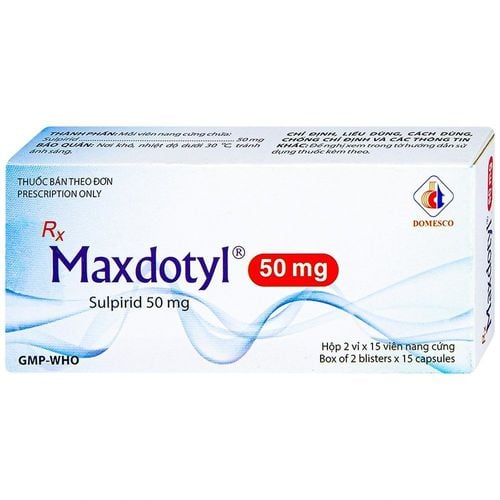This is an automatically translated article.
Cabergoline has agonist activity on Dopamine D2 receptors, and inhibits Prolactin secretion. Cabergoline is therefore indicated for the treatment of Parkinson's disease or prolactin hypersecretion. So what principles should be followed when using Cabergoline?
1. What is Cabergoline?
What is Cabergoline? Cabergoline is essentially a Dopaminergic Ergoline derivative with potent and long-lasting agonist properties on the D2 dopamine receptor. Cabergoline improved motor deficits in animal studies with Parkinson's disease at daily oral doses of 1-2.5 mg/kg in rats and 0.5-1 mg/kg subcutaneously in monkeys.
In humans, the use of a single oral dose of cabergoline 0.3-2.5 mg was associated with a significant reduction in serum prolactin concentrations, specifically for this effect (including extent and duration of action). will be dose related.
The pharmacodynamic effect of Cabergoline, which is not related to treatment, is a decrease in blood pressure, which usually occurs in the first 6 hours after dosing and is dose dependent.
Cabergoline is available in 1mg and 2mg strengths.
2. What effect does Cabergoline have?
With the above use, Cabergoline is indicated in the following cases:
Treatment of Parkinson's: Cabergoline is only a second-line monotherapy or in combination with Levodopa/dopamine decarboxylase enzyme inhibitor; Treatment of hyperprolactinemia due to causes such as pituitary adenoma or idiopathic. Cabergoline is contraindicated for use in the following patients:
Allergy to Cabergoline or Ergot derivatives or any of the ingredients in the drug; History of heart valve disease, pulmonary fibrosis, pericardial disease...; Patient has uncontrolled high blood pressure.
3. Dosage, how to use Cabergoline
Dosage of Cabergoline in adults and the elderly:
Treatment of parkinsonism: Initial dose of 1mg, taken once daily. Then, depending on response, increase increments of 0.5-1mg/day weekly or every 2 weeks until optimal dose. The maintenance dose of Cabergoline in the treatment of Parkinson's is 2-6mg/day; Treatment of hyperprolactinemia: Initial dose: 0.25 mg x 2 times/week, increased by 0.25mg increments up to 1mg x 2 times/week depending on the patient's blood prolactin concentration. Consider reducing the dose of Cabergoline when serum prolactin levels return to normal for at least 24 months and tumor size is reduced by more than 50%. In other subjects, a reduction in the dose of Cabergoline should be considered if liver function is severely impaired.
How to take Cabergoline:
Patients should take Cabergoline with meals; Note that Cabergoline should be started at a low dose, then increased gradually (1 or 2 weeks apart) until a maximal therapeutic response is achieved.
4. Cabergoline side effects
Some very common side effects of Cabergoline:
Heart valve abnormalities, inflammation and/or pericardial effusion; Peripheral edema. Common side effects of Cabergoline:
Angina; Headache; Drowsiness or sleep disturbances Dizziness, movement disorders; The appearance of hallucinations; Increase sex drive; Confusion; Postural hypotension; Constipation, indigestion, gastritis, vomiting; Weak body; Decrease in hemoglobin concentration, hematocrit and red blood cell count. Some uncommon and rare undesirable effects of Cabergoline:
Pleural effusion, pulmonary fibrosis; Symptoms of hypersensitivity reactions; Delusions or psychosis; Neuropathic myalgia; Edema, fatigue; Abnormal liver function tests; Rash; pleural fibrosis; Respiratory failure, pleurisy; Increase movement; Sudden onset of sleep, fainting, tremors; Aggressive, extreme; Patchy hair loss; Cramp ; Increased blood creatine phosphokinase.
5. Cabergoline drug interactions
Cabergoline should not be used concurrently with drugs with Dopamine antagonist activity (such as Phenothiazines, Butyrophenones, Thioxanthenes, Metoclopramide ) because they may reduce the therapeutic effect.
As with other ergot derivatives, patients should not take Cabergoline concomitantly with macrolide antibiotics (eg, erythromycin) because of the potential for increased systemic bioavailability.
Alcohol can increase the side effects of Cabergoline on the nervous system such as dizziness, drowsiness and difficulty concentrating. Therefore, patients should stop or limit alcohol use during treatment with Cabergoline.
6. Precautions when using Cabergoline
Caution should be taken when prescribing Cabergoline to patients with a history of or existing severe cardiovascular disease, Raynaud's syndrome, peptic ulcer or gastrointestinal bleeding, or serious mental disorders (especially in psychotic).
Patients with hereditary disorders of galactose intolerance, the lapp lactase deficiency or glucose-galactose malabsorption should not take Cabergoline.
Patients with severe hepatic impairment are advised to use only low doses of Cabergoline. Studies between normal volunteers and patients with hepatic impairment reported an increase in AUC in severe hepatic impairment (Child-Pugh C) despite a single dose of 1 mg.
Orthostatic hypotension may occur after taking Cabergoline, especially during the first period of treatment. This warns that caution should be exercised when combining Cabergoline with other antihypertensive drugs.
Fibromyal and serosa conditions such as pleural inflammation/effusion/fibrosis, pulmonary fibrosis, pericardial inflammation/effusion, valvular disease (involving one or more valves such as the aorta, mitral and 3 leaves) or retroperitoneal fibrosis has occurred in patients with prolonged use of Ergot derivatives with the serotonin 5 receptor agonist HT-2B, which includes the drug Cabergoline. In some cases, symptoms or manifestations of valvular heart disease improve after stopping Cabergoline.
Before initiating long-term treatment with Cabergoline, all patients should have cardiovascular function evaluated, including echocardiography, to detect the potential presence of asymptomatic valvular disease.
Cabergoline-associated fibrosis can have a silent onset, so patients should be monitored regularly for early symptoms of advanced fibrosis, including:
Pleural disease and lungs: shortness of breath, persistent cough or chest pain; Renal failure, obstruction of the ureters or intra-abdominal blood vessels with symptoms such as back pain, leg edema, or the presence of abdominal masses may be manifestations of retroperitoneal fibrosis. Cabergoline has been associated with somnolence and sudden episodes of sleep in patients with Parkinson's disease.
Patients treated with Cabergoline should be regularly monitored for the development of impulse control disorders. In particular, it is necessary to pay attention to behavioral symptoms such as gambling addiction, increased sexual desire, lust, compulsive spending or shopping, binge eating or compulsion... as they can occur in patients treated with dopamine agonists. Dosage reduction of Cabergoline should be considered if the patient develops these symptoms.
There are no adequate studies on the safety of using Cabergoline in pregnant women. Animal studies have not demonstrated teratogenic effects, but Cabergoline may reduce fertility or pose a risk of embryotoxicity. Therefore, Cabergoline should only be used during pregnancy if there is a clear indication and an accurate benefit/risk assessment is required.
In rats, Cabergoline and/or its metabolites can be excreted in human milk. Although there are no studies on excretion in human milk, Cabergoline may inhibit or inhibit lactation. Therefore, during treatment with Cabergoline, women should not breast-feed.
Cabergoline can cause unwanted effects such as drowsiness and sudden sleep episodes in Parkinson's patients. Therefore, patients who are being treated with Cabergoline and have drowsiness should be cautious when driving and operating machinery.
In summary, Cabergoline is essentially a Dopaminergic Ergoline derivative with potent and long-lasting agonist properties on the D2 Dopamine receptor. Cabergoline is indicated for the treatment of Parkinson's disease or hypersecretion of prolactin.
Follow Vinmec International General Hospital website to get more health, nutrition and beauty information to protect the health of yourself and your loved ones in your family.
Reference source: drugs.com













